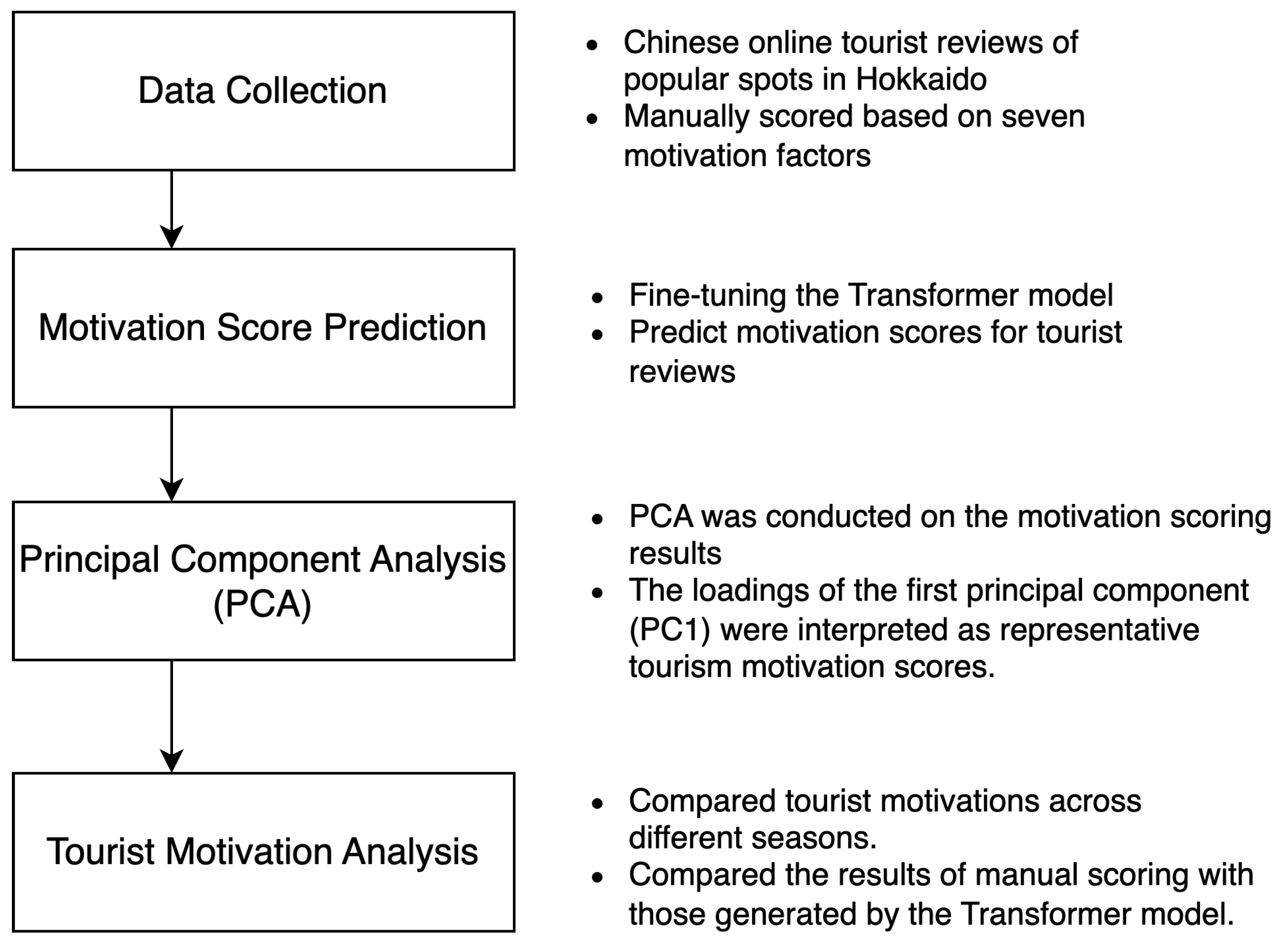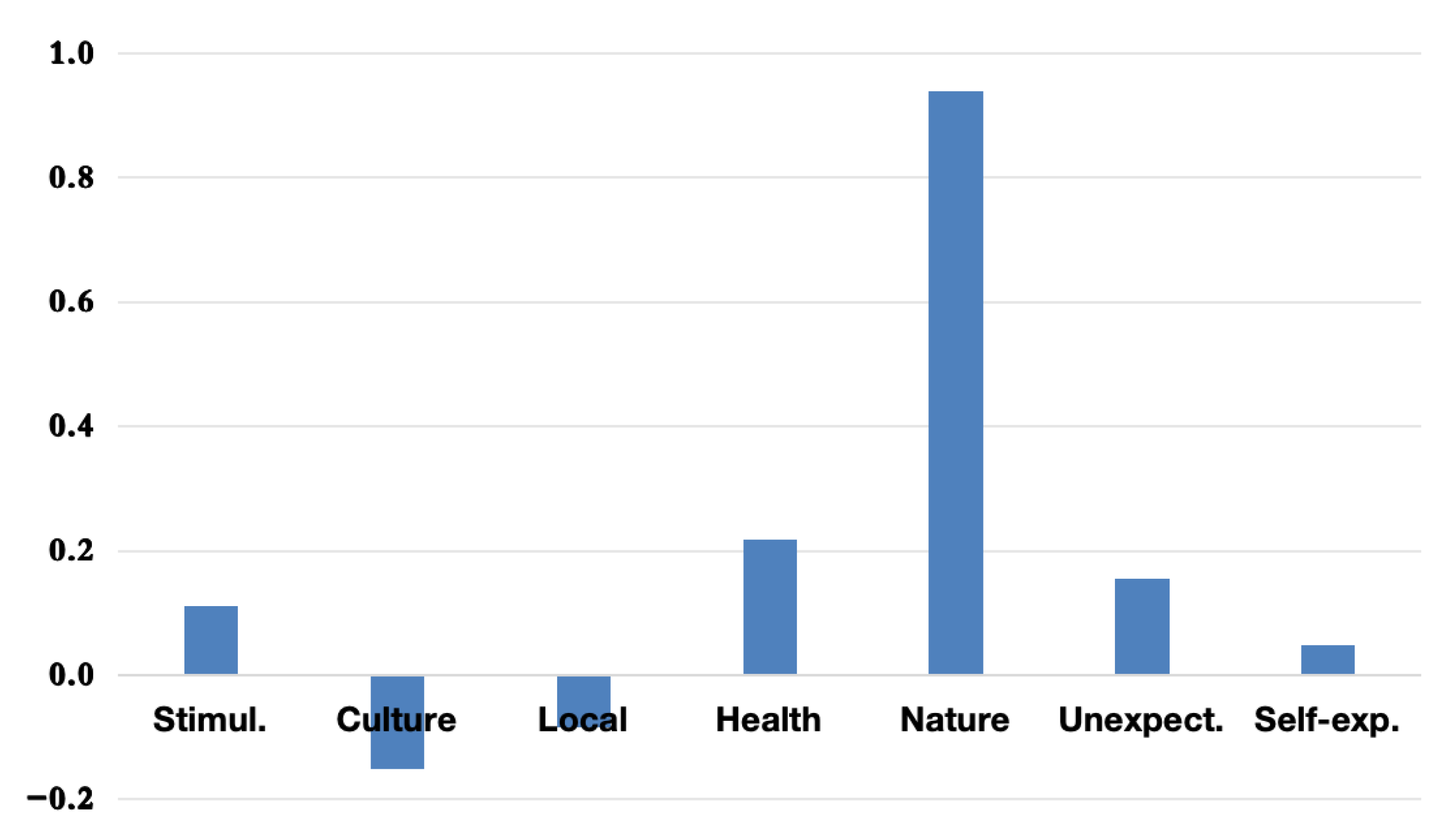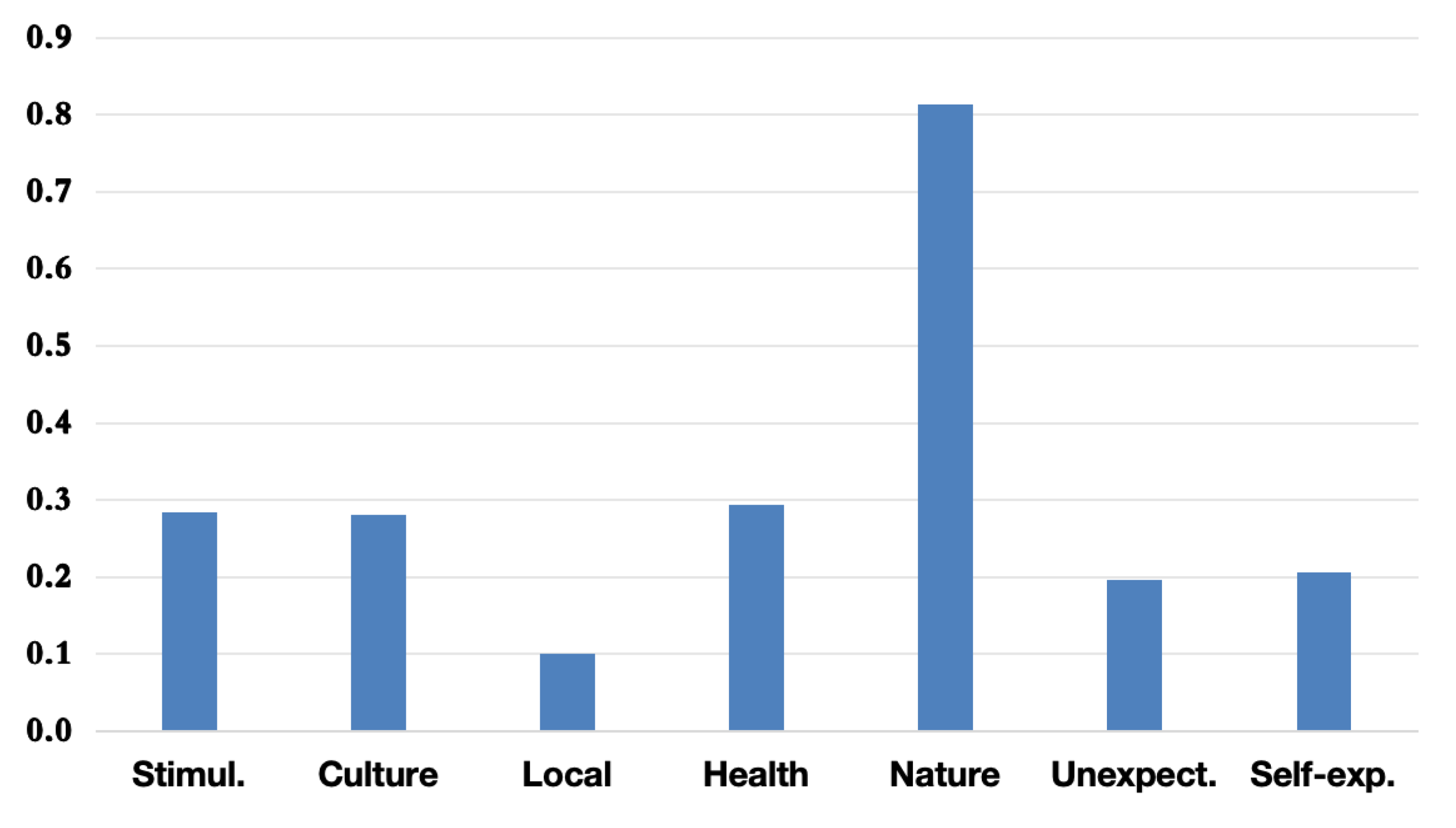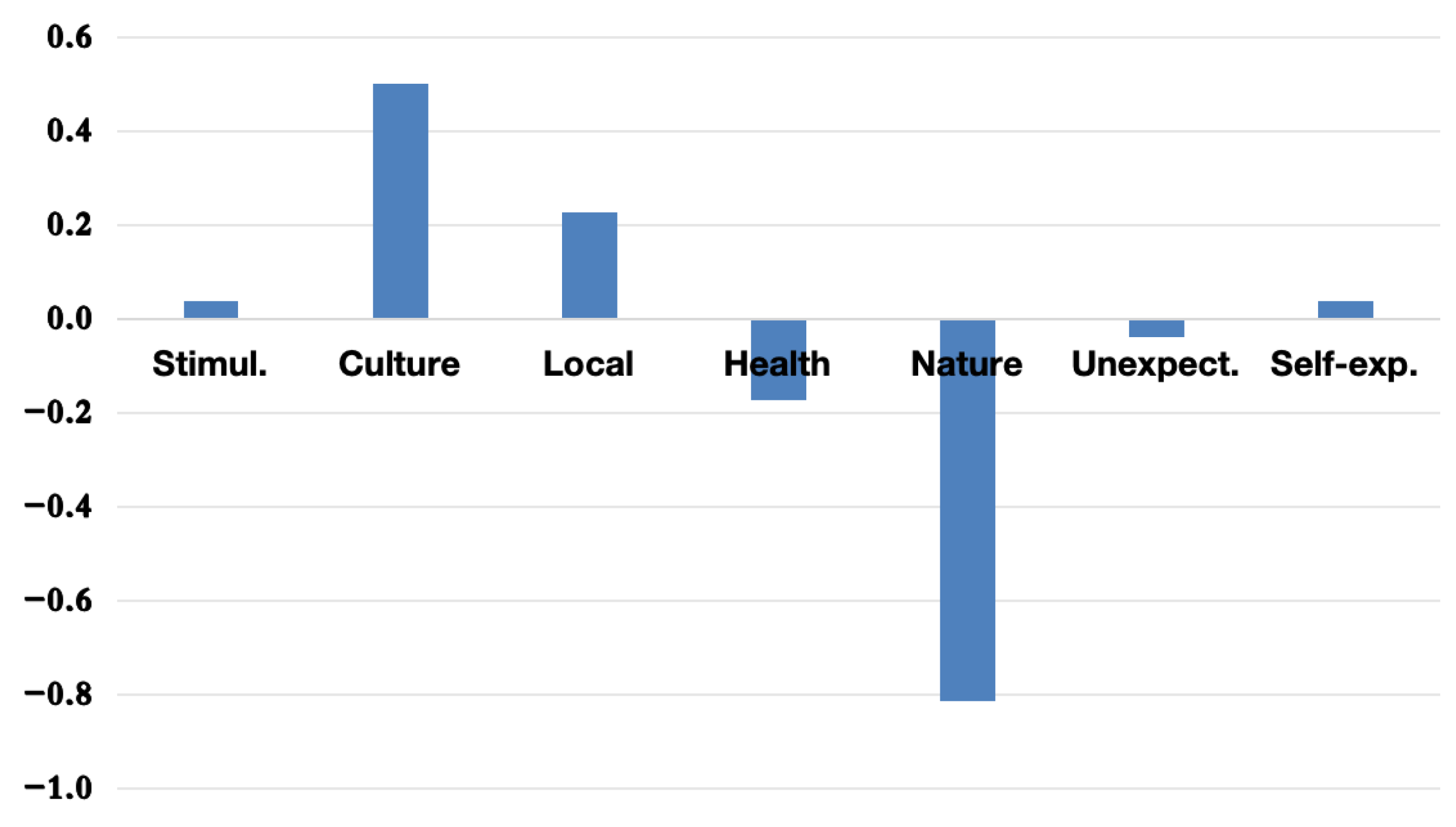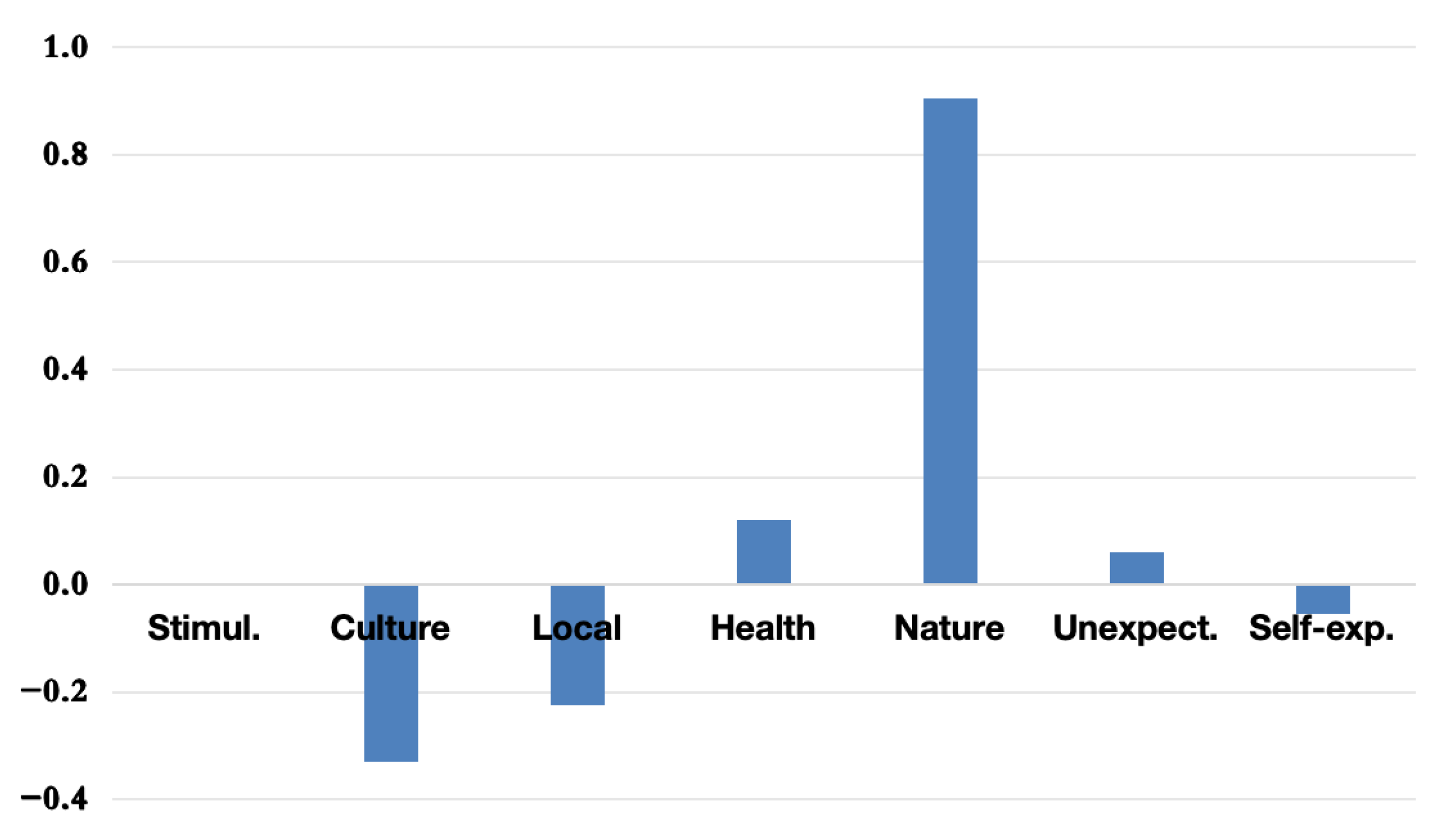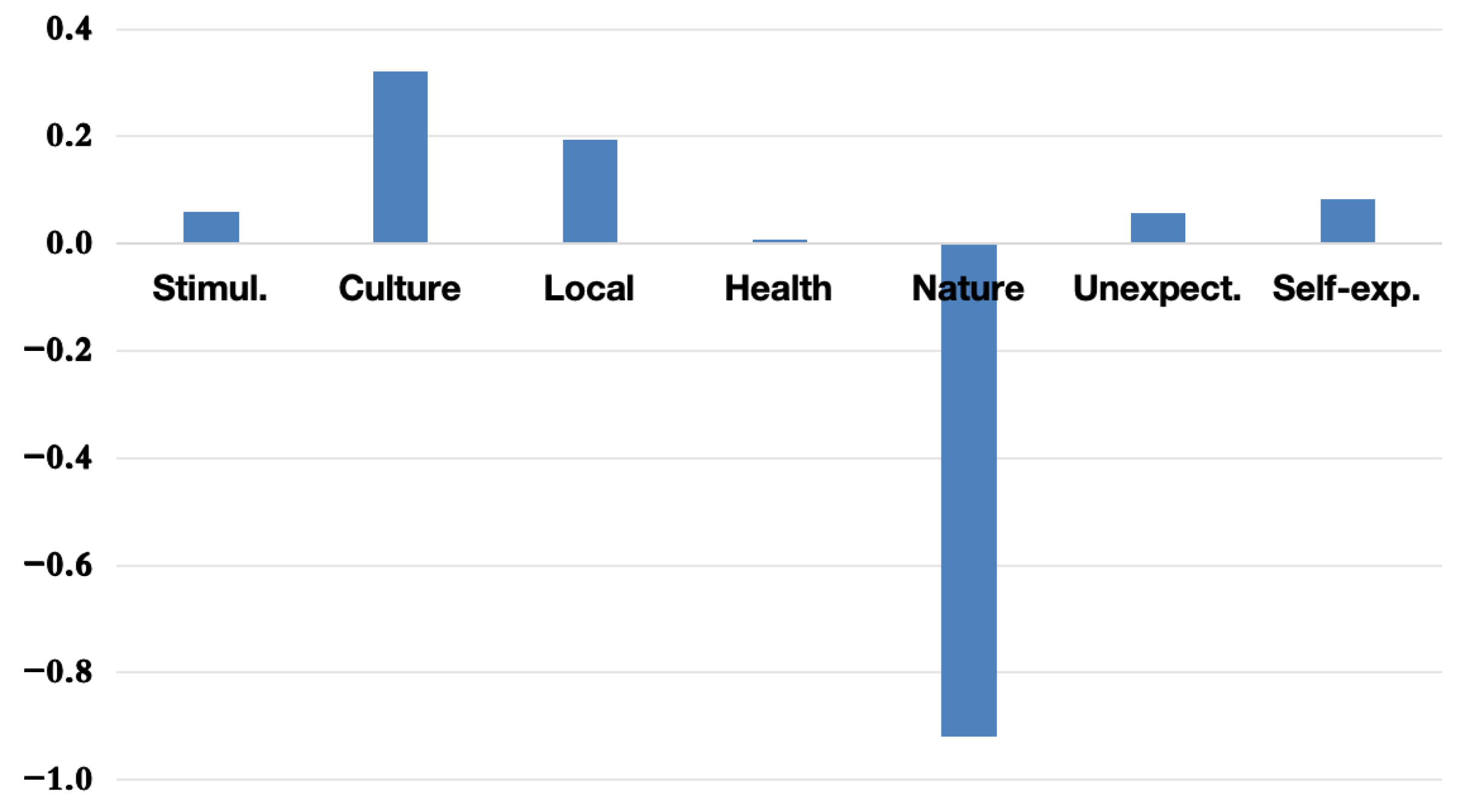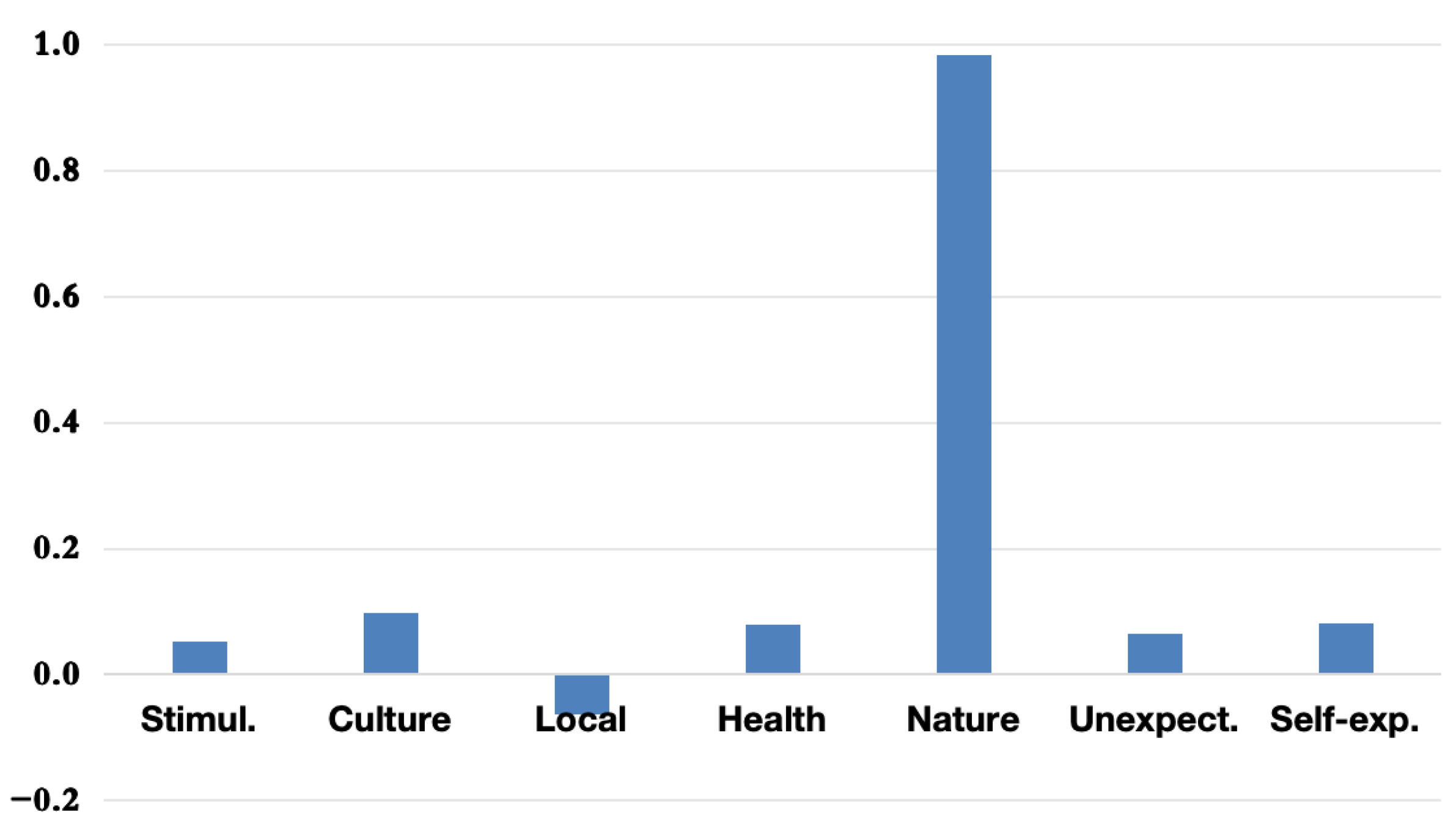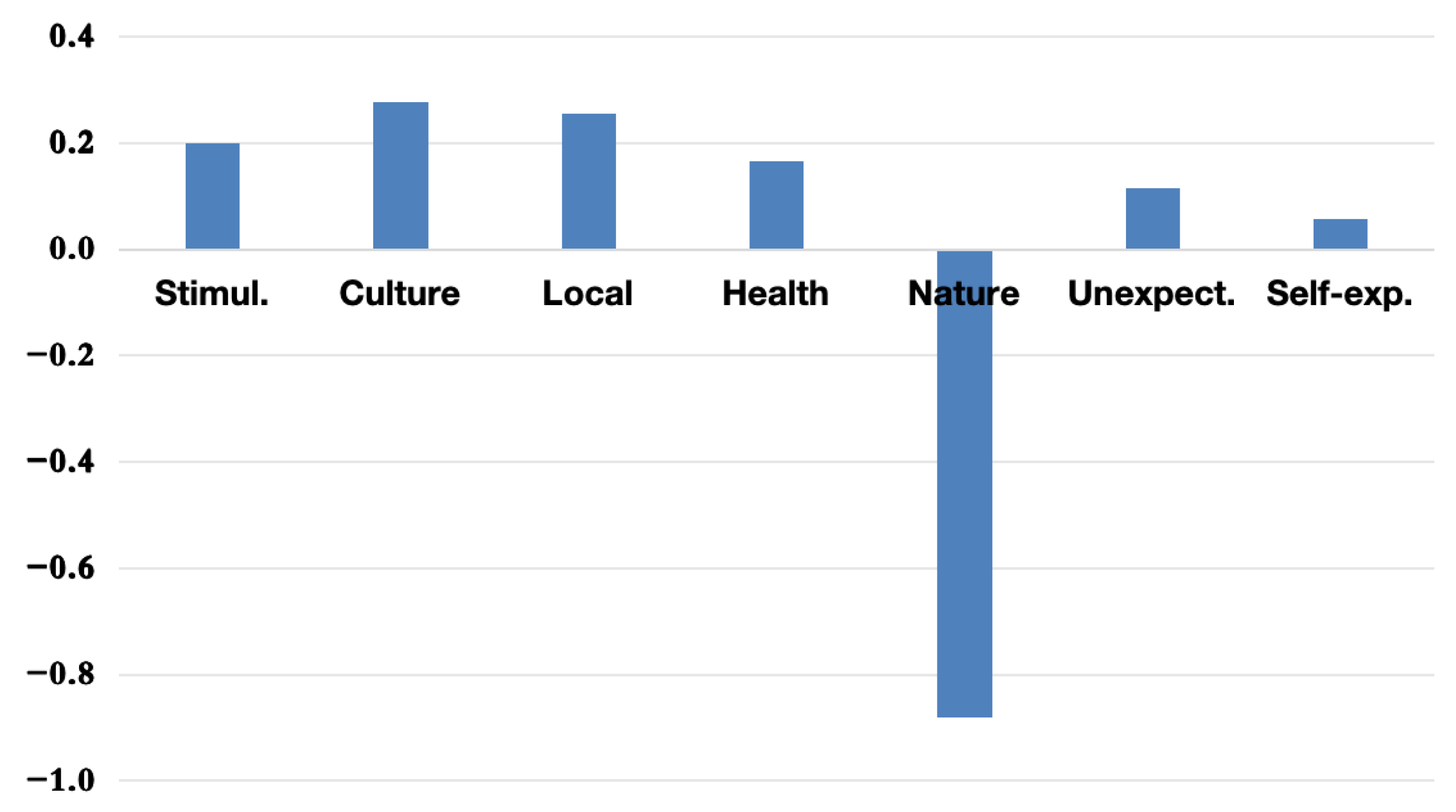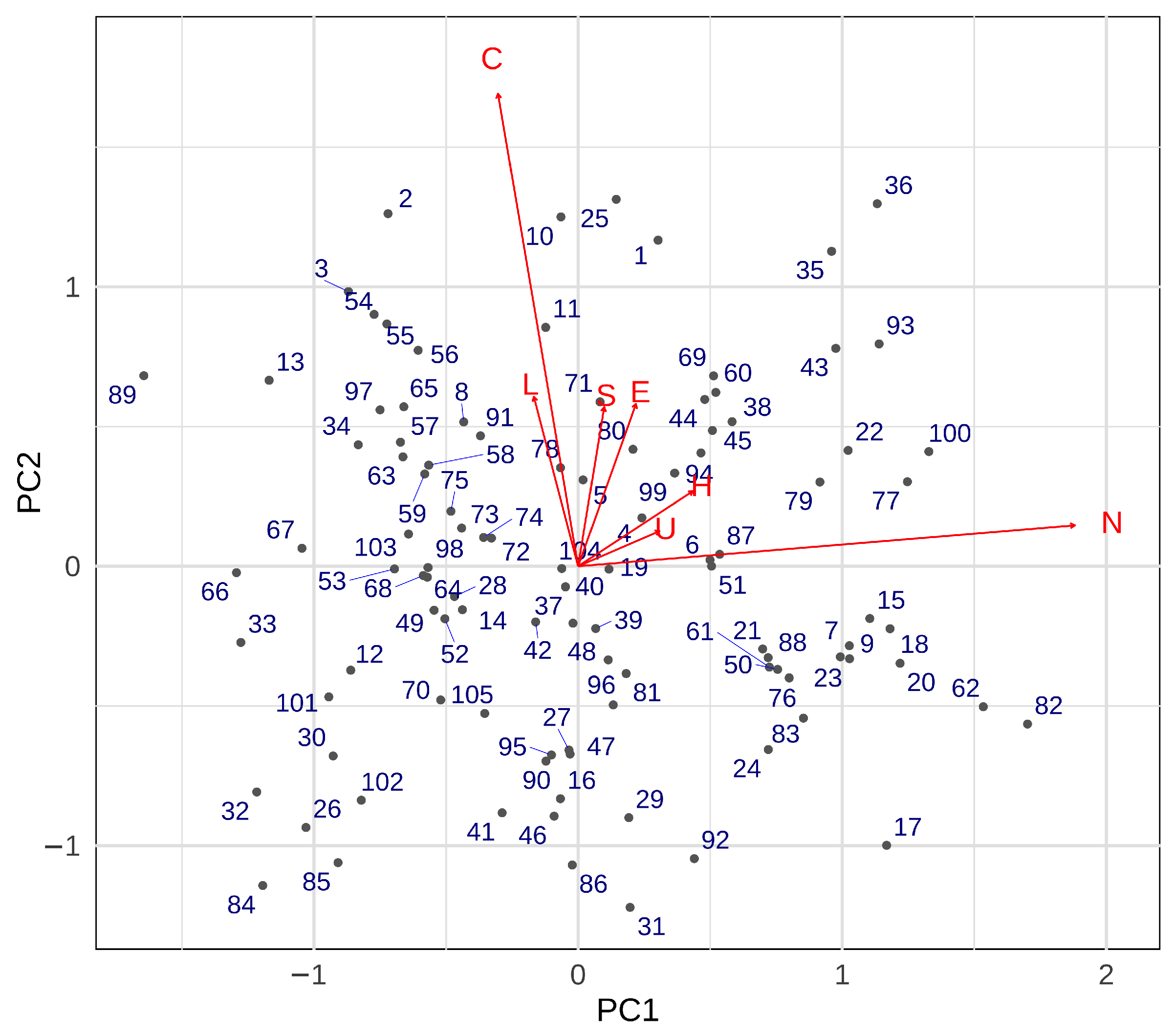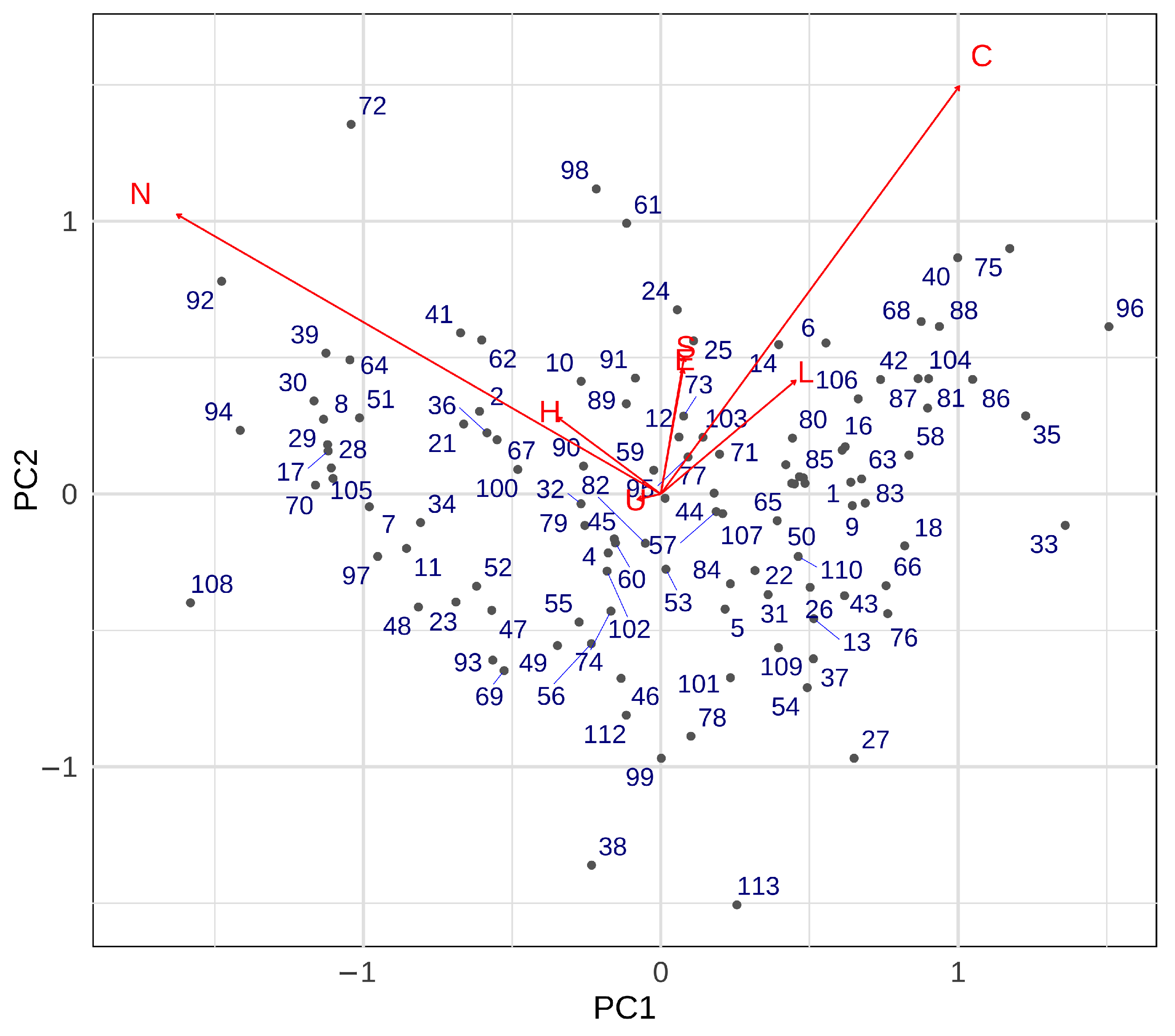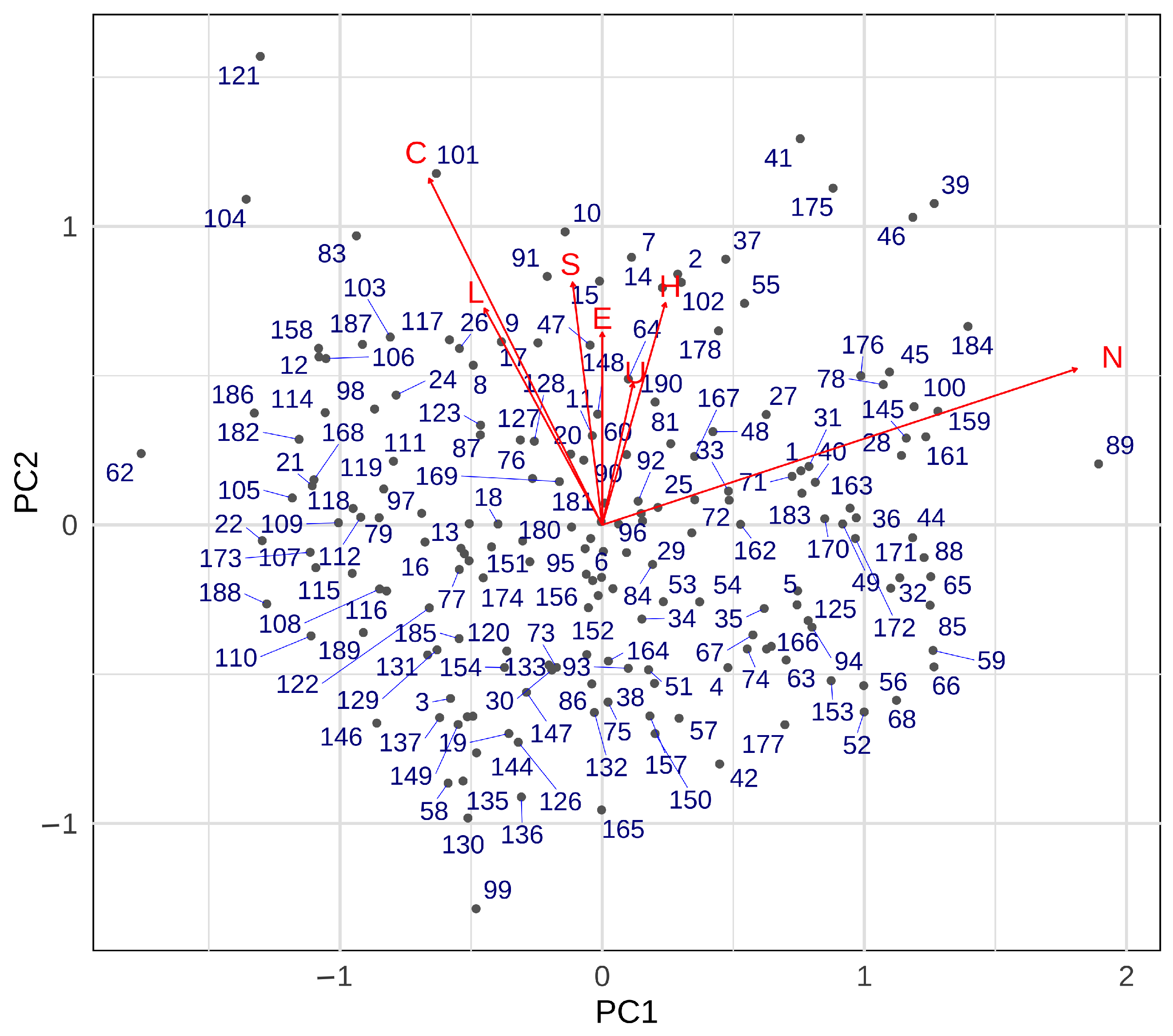1. Introduction
The COVID-19 pandemic brought significant disruptions to the global tourism industry, with Japan experiencing a dramatic decline in inbound visitors due to prolonged travel restrictions and public health concerns (
UN Tourism, 2023). However, as borders reopened and international travel gradually resumed, Japan has witnessed a strong resurgence in tourism, particularly from China, which has historically been one of its largest and most influential tourist markets (
JNTO, 2024). Within Japan, the Hokkaido region stands out as a major attraction, known for its natural beauty, seasonal festivals, hot springs, and distinct cultural offerings. As competition intensifies in the global tourism market, understanding what motivates Chinese tourists to visit specific destinations in Hokkaido has become a critical challenge for policymakers, local governments, and businesses seeking to revitalize and sustain the tourism sector.
Following the post-pandemic recovery, Japan has experienced a surge in inbound tourism, with Chinese visitors once again making up a significant portion of the international traveler population (
The Japan Times, 2024). However, this growth has not been evenly distributed across the country. Government data released in mid-2024 revealed that tourism in Japan’s major metropolitan areas, namely Tokyo, Osaka, and Aichi, has seen notable growth since 2019, while rural regions have suffered a marked decline in visitor numbers (
Japan Tourism Agency, 2024). This widening urban–rural divide underscores the critical need to better understand what drives tourists to explore less-traveled destinations like Hokkaido. Given the importance of enhancing destination marketing strategies and improving visitor experiences, a deeper understanding of Chinese tourists’ motivations for traveling to Japan, especially to regions outside the urban core, is essential for promoting more balanced and sustainable tourism development (
Chul Oh et al., 1995;
Yuan & Mcdonald, 1990).
Traditional approaches to tourism motivation research have primarily relied on surveys (
Cohen, 1972;
Crompton, 1979), structured interviews, and classic theoretical models such as push–pull theory (
Dann, 1981) and means–end chain theory (
Gutman, 1982). While these methods have contributed significantly to our understanding of tourist behavior, they are constrained by inherent limitations: small sample sizes, potential respondent biases, and difficulties in capturing dynamic and evolving preferences. In the digital era, user-generated content (UGC) from social media platforms and travel review sites presents a rich and underutilized resource for uncovering insights into tourist motivations (
Ana & Istudor, 2019). However, manually analyzing such large-scale textual data is impractical, prompting the need for more sophisticated and automated solutions.
Transformer models, particularly pre-trained large language models (LLMs) based on the Transformer architecture like BERT (
Devlin et al., 2019) and RoBERTa (
Y. Liu et al., 2019), have achieved impressive results in understanding deep text semantics, yet their application to tourism motivation research remains relatively rare. In addition, principal component analysis (PCA) has proven useful in tourism analytics for dimensionality reduction, helping to distill key motivational factors from large datasets processed by Transformer models.
To address this gap, we build on our previous research (
Z. Liu et al., 2025,
2023) by applying an automatic system to extract tourism motivations from online reviews, with a focus on identifying dominant motivational factors at different tourist spots. Specifically, we employ RoBERTa to semantically analyze and score reviews according to predefined motivational dimensions, such as self-expansion, excitement, natural experience, local interaction, cultural observation, and health recovery. These dimensions are grounded in the established tourism motivation literature and refined through our earlier studies. After computing individual motivation scores for each review, we apply principal component analysis (PCA) to reduce data dimensionality and identify the most prominent motivational factor for each destination.
The goal of this study is to apply and validate an AI-driven framework capable of automatically identifying and analyzing tourism motivations from large-scale textual data, with a focus on Chinese reviews of Hokkaido. By integrating advanced natural language processing (NLP) with statistical modeling techniques, we seek to improve the efficiency and depth of motivation analysis in tourism research.
This study makes several key contributions:
We develop an end-to-end framework that combines LLM-based motivation scoring with principal component analysis (PCA) and clustering to automatically extract latent motivational factors from user-generated tourism reviews.
We apply this framework to Chinese tourist reviews of Hokkaido, uncovering spatial and seasonal patterns in motivational drivers, while evaluating the model’s interpretive performance against expert-coded annotations to assess its strengths and limitations in capturing abstract, context-sensitive constructs.
We translate these findings into data-driven recommendations for tourism practitioners to inform destination branding, enhance visitor experience design, and tailor marketing strategies more effectively.
By bridging the gap between AI technologies and tourism studies, this research highlights the potential of automated text analysis in capturing evolving traveler preferences and contributes to the growing body of research on AI-enhanced tourism analytics.
This study aims to understand how tourism motivations vary across different seasons and locations in Hokkaido, and how a hybrid computational approach can uncover meaningful behavioral patterns. We pose the following research questions:
RQ1: What are the dominant motivational themes expressed by Chinese tourists across key destinations in Hokkaido?
RQ2: How do these motivational patterns shift by season, and what spatial–temporal trends emerge?
RQ3: How can transformer-based models and statistical techniques be integrated to reveal latent motivation structures?
RQ4: What implications do these seasonal and locational motivation profiles have for targeted tourism development and rural revitalization strategies in Japan?
These questions are rooted in classical tourism motivation theories (e.g., push–pull dynamics and socio-psychological motives) and are extended through data-driven methods that allow for detailed analysis across different seasons and geographic locations.
3. Method and Experiment
This study adopts a hybrid methodology that integrates advanced natural language processing (NLP) techniques with statistical modeling to identify and interpret the underlying motivations of Chinese tourists visiting Hokkaido. The approach builds on prior work in computational tourism research and aims to overcome the limitations of traditional survey-based methods by leveraging large-scale user-generated content (UGC). The overall workflow is depicted in
Figure 1 and comprises four major phases: (1) data collection, (2) motivation score prediction using a fine-tuned Transformer model, (3) dimensionality reduction through principal component analysis (PCA), and (4) validation and analysis of motivational patterns. Each step is described in detail in
Section 3.1,
Section 3.2,
Section 3.3 and
Section 3.4.
3.1. Data Collection
The first step involved the collection of large-scale textual data from Chinese tourists who had visited Hokkaido, following the approach of
Z. Liu et al. (
2023). Data were sourced from
https://ctrip.com/ (accessed on 8 May 2025), one of the most prominent Chinese travel platforms, known for its rich repository of user-generated reviews and travel narratives. We selected Hokkaido due to its seasonal diversity, cultural distinctiveness, and popularity among Chinese tourists, making it an ideal case study for motivation analysis.
A total of 500 review entries were curated to ensure diversity in content, length, and tourist destinations. The dataset included reviews spanning different cities (e.g., Sapporo, Otaru, Furano), attractions (e.g., Shiroi Koibito Park, Noboribetsu Hell Valley, Hokkaido Shrine), and from different seasons. This ensured that both temporal (seasonal) and spatial (location-specific) variations could be explored.
For model training and evaluation purposes, the collected reviews were manually annotated according to seven motivation dimensions based on the framework proposed by
Hayashi and Fujihara (
2008). These dimensions, stimulation, cultural observation, local communication, health recovery, experiencing nature, unexpectedness, and self expansion, were chosen due to their grounding in the tourism psychology literature and their prior validation in the context of Japanese tourism. Each review was independently evaluated and scored by five Chinese annotators to ensure reliability. The definitions of the motivation factors are presented in
Table 1, and the scoring criteria are detailed in
Table 2. Five native Chinese participants were asked to independently score each review based on their judgment, using the provided motivation definitions and the perceived relationship between the review content and each factor. To ensure inter-rater reliability, we calculated the coefficient scores between the participants. The results confirmed a good level of agreement, and the final score for each review was obtained by averaging the scores from all five participants.
3.2. Motivation Score Prediction
The second phase aimed to automatically infer the motivational content of each review using Transformer-based NLP models. We employed RoBERTa, a robustly optimized variant of BERT, known for its superior performance in semantic understanding tasks. RoBERTa was pre-trained on a large corpus of Chinese text and subsequently fine-tuned on our manually annotated dataset.
RoBERTa (
Y. Liu et al., 2019) is an improved variant of BERT designed to strengthen language representation through modifications to its pre-training strategy. It achieves this by eliminating the Next Sentence Prediction objective, applying a dynamic masking scheme during masked language modeling, and training on a significantly larger and more diverse corpus. These enhancements result in a more stable and effective model for capturing contextual information in downstream NLP tasks.
In contrast to conventional machine learning techniques, which often depend on manual extraction of features and are limited by fixed input lengths, Transformer models like RoBERTa utilize self-attention mechanisms that evaluate the significance of every token in the sequence relative to others. This structure allows them to effectively model complex, long-range dependencies that traditional models like SVMs or RNNs struggle to handle (
Vaswani et al., 2017). Additionally, because Transformers are pre-trained on massive text datasets and later adapted through fine-tuning, they offer enhanced flexibility and performance across a wide range of language-related tasks. Their adaptability and power have made them the core architecture for leading models in tasks such as text generation, translation, and summarization.
Our decision to use a fine-tuned RoBERTa model is grounded in both theoretical and empirical considerations. RoBERTa outperforms earlier transformer architectures such as BERT in multiple NLP benchmarks due to its optimized pretraining strategy, including dynamic masking, longer training, and the removal of Next Sentence Prediction (
Y. Liu et al., 2019). In our previous research (
Z. Liu et al., 2025), RoBERTa consistently outperformed alternative models on our dataset, reinforcing its suitability for fine-grained motivation modeling.
The fine-tuning process treated the task as a multi-output regression problem, following the approach of
Z. Liu et al. (
2025), in which the model was trained to predict seven continuous scores—each representing the intensity of a specific motivational dimension—on a 1 to 5 scale. This setup enabled the model to capture the relative salience of multiple motivations within a single review, rather than constraining the task to single-label classification. Input reviews were tokenized using RoBERTa’s Byte-Pair tokenizer. All models were initialized from Hugging Face’s Transformers library and fine-tuned using the PyTorch (2.6.0) framework. Given the limited size of the labeled dataset, we adopted a conservative training strategy that included a small learning rate (e.g.,
), a larger number of epochs (typically >10), and early stopping based on validation loss.
The model was applied to a total of 500 reviews not seen during training, generating a seven-dimensional motivation score vector for each entry. These vectors represent the semantic alignment of each review with the target motivational constructs, enabling quantitative analysis of otherwise subjective tourist sentiments.
3.3. Principal Component Analysis
To synthesize the high-dimensional motivational data and extract key patterns, we applied principal component analysis (PCA) to the predicted score vectors. PCA is a widely used unsupervised method for identifying latent structure in multivariate data and has been employed in tourism analytics for purposes such as segmentation, trend detection, and behavior clustering. It is commonly used in data analysis to simplify high-dimensional datasets by identifying a smaller set of new variables—known as principal components—that capture the most significant patterns of variation (
Abdi & Williams, 2010). In other words, PCA is a method for simplifying complex data by combining overlapping variables into a smaller number of summary dimensions. It is useful for identifying the most important patterns in data without losing key information.
In this study, PCA served two primary purposes. First, it reduced redundancy among the correlated motivation scores, providing a compressed representation that emphasizes the most salient variance in the dataset. Second, it enabled visualization and interpretation of dominant motivational trends across different reviews and destinations.
We focus on the first principal component (PC1) because it captures the largest share of total variance in the multidimensional motivation–score space. In principal component analysis (PCA), each principal component is defined as an orthogonal linear combination of the original variables, ordered by the amount of variance they explain in the data; PC1 corresponds to the eigenvector of the covariance matrix with the largest eigenvalue, thereby maximizing the projected variability. In geometric terms, it defines the direction in the data space along which the observations vary most. This makes it the most informative axis for summarizing the dominant patterns in the motivation data. The coefficients, or loadings, associated with PC1 indicate how much each original variable contributes to this composite dimension. In this case, the loadings of PC1, which are the coefficients that associate each original motivation factor with this component, indicate how strongly each factor contributes to the dominant pattern of variation in the data. Consequently, the motivation factor with the highest absolute loading on PC1 is interpreted as the primary driver of tourist behavior in our dataset. By extracting and examining PC1 loadings from the RoBERTa-scored motivation vectors, we thus identify the single most salient motivation dimension (e.g., Nature, Culture) that underlies the greatest amount of variation across all reviews. These PC1 loadings were interpreted as composite motivation scores for each tourist destination. For instance, if the “health recovery” factor had the highest loading on PC1 for a given site, this would suggest that visitors primarily associated that location with relaxation, well-being, or restorative experiences in natural or calming environments. This approach provides a clear, statistically grounded method for isolating the main tourist motivation without arbitrary thresholds or subjective weighting.
While non-linear dimensionality reduction techniques such as t-SNE (
Van der Maaten & Hinton, 2008) and UMAP (
McInnes et al., 2018) are valuable for visualizing clusters, they lack the interpretability of PCA, particularly in terms of loadings that quantify how each original motivation dimension contributes to a principal component. By analyzing PCA loadings, we are able to identify dominant motivational combinations and assess how these patterns shift across seasons. Our use of PCA builds on our prior work in tourism analytics (
Z. Liu et al., 2023), which applied PCA to expert-annotated review data. In contrast, our study extends this methodology by applying PCA to outputs generated by a fine-tuned large language model (RoBERTa), enabling scalable, automated motivation profiling while retaining psychological interpretability and seasonal resolution.
We conducted principal component analysis on the motivation scores of 500 reviews to identify the main tourism motivations in Hokkaido. In addition, the reviews were grouped by season to compare variations in tourist motivations across different times of the year.
3.4. Tourist Motivation Analysis
In the final phase of the study, we analyzed the motivational patterns derived from the PCA results to gain insights into the dominant factors influencing Chinese tourists’ visits to Hokkaido. This analysis aimed to assess the real-world applicability of the automated framework by identifying seasonal trends and spatial variations in tourist motivations across different attractions.
To evaluate the performance of the RoBERTa-based motivation scoring system, we compared PCA results derived from the model-generated scores with those based on human-annotated scores. This comparison enabled us to assess the extent to which the model could replicate expert judgment in identifying key motivational dimensions. The reviews were segmented by season—spring, summer, fall, and winter—to explore how tourist motivations vary throughout the year. By analyzing principal component loadings for each seasonal subset, we identified temporal patterns in motivational salience, thereby validating the model’s ability to capture context-sensitive shifts in tourist behavior.
5. Discussion
Our results show that the RoBERTa-based scoring system successfully approximates human annotations for key motivation dimensions. The Intraclass Correlation Coefficients (ICCs) indicate particularly strong alignment in concrete categories such as Nature and Culture, supporting the reliability of our automated pipeline. These results affirm that LLM-based scoring can replicate expert judgment across large datasets, offering a scalable alternative for tourism motivation analysis.
However, the model demonstrated more limited performance for abstract constructs such as self-expansion and excitement, which are often implicit or emotionally nuanced. This reflects a known challenge for LLMs in interpreting introspective or affective states, and suggests that further refinement, such as the integration of multimodal data, such as the additional usage of images or geotagged itineraries from SNS, or fine-grained contextual modeling like sequence-aware architectures (e.g., hierarchical transformers), may improve accuracy in these areas.
One of the study’s key contributions lies in its exploration of seasonal shifts in tourist motivations. By grouping reviews according to season and applying PCA to both human-annotated and model-predicted scores, we identified distinct patterns in what motivates Chinese tourists across different times of the year.
The key findings are discussed below:
- 1.
Spring Season—Nature Motivation with Seasonal Transition
Spring is characterized by a high loading on nature motivation, as reflected in many reviews. Tourists visiting in March and early April often encounter lingering snow in areas like Asahiyama Zoo and Noboribetsu, while those visiting in late April to May experience blooming sakura, particularly in Sapporo and Odori Park.
For example, Review No. 62 (
Figure 12) states, “Hokkaido Jingu is a world of snow in winter. The snowy area is vast and highly recommended”. In contrast, Review No. 100 notes, “In spring, many Japanese people would have a picnic in Enoyama Park, and it was very crowded. Visitors can also enjoy the cherry blossoms planted next to the shrine”. These reviews support the conclusion that nature is the core draw in spring, but with seasonally segmented appeal depending on the timing of the trip.
- 2.
Summer Season—Diverse Motivations with Emphasis on Nature, Stimulation, and Self-Expansion
Summer reviews show high PC1 loadings for nature, as well as strong secondary loadings on stimulation, unexpectedness, health, and self-expansion. Tourists are exposed to Hokkaido’s vibrant natural beauty and outdoor activities, including lavender fields in Furano, flower gardens in Shiroi Koibito Park, and festivals like the Sapporo Summer Festival.
For instance, Review No. 69 (
Figure 13) expresses, “You can visit the Chocolate Museum at the factory where the famous White Lover sweets are made. In addition to learning about the history of chocolate, there is also a nostalgic toy museum, a dessert buffet, and a workshop where you can try your hand at making Kotatsu biscuits. In summer, the rose garden in the park is filled with more than 1000 roses of 200 varieties, including English roses and old roses”. Likewise, Review No. 65 notes, “I thought it was a small park, but after walking around, I realized that it is a big park, and it actually takes about 30 min to walk from the beginning to the end. Along the way, there are not only beautiful trees, but also tulips and other unknown flowers for decoration, making it a very comfortable environment”. These comments explain the PCA results: visitors feel stimulated, mentally renewed, and enriched by their summer travels, contributing to the high loadings on both emotional engagement and self-growth.
- 3.
Fall Season—Strong Cultural and Natural Motivations
In the fall season, both culture and nature emerged as the dominant motivational factors, with cultural motivation noticeably higher compared to other seasons. This result reflects a shift in focus toward cultural appreciation, likely due to the seasonal decline in iconic natural elements such as flower blooms or deep snow.
From the PCA score plot, for example, reviews No. 96 and 35 (
Figure 14) are located in the high-load region of cultural motivation. Review No. 96 mentions the following: “On the west side of Otaru Canal, crossing the street is Izubakoji, which is really small and narrow, as it was when it was built about a hundred years ago, and it is full of restaurants and small stores. Further west is an abandoned railroad, and you can imagine how the Hokkaido pioneers lived and worked here”. Similarly, Review No. 35 notes, “The kerosene street lamps and vintage masonry warehouses along the canals emphasize the city’s literacy, and there are many artists painting and taking pictures along the banks”. These examples show that in fall, tourists are drawn to culturally enriching experiences.
While nature is still valued in fall—e.g., the autumn foliage around Otaru lakes is frequently praised—tourists tend to focus more on human heritage and cultural context, possibly due to fewer seasonal natural spectacles compared to spring or winter.
- 4.
Winter Season—Strong Nature Motivation Dominated by Snow Experience
Winter in Hokkaido is widely known for its snowy landscapes, and PCA results confirm that nature is the strongest motivational factor. The reviews consistently highlight attractions like the Sapporo Snow Festival, snow-covered Otaru Canal, and hot springs near Noboribetsu Hell Valley.
From the PCA plot, Review No. 184 (
Figure 15) says, “In the snow-covered, the shrine has a touch of romance, look at the snow under the shrine pedestrians, hurried footsteps, more than a leisurely. Here, I also met, a cute little squirrel, because the winter, its hair grows especially much, especially fluffy, fat and round with the cartoon almost, really cute”. These examples confirm that Hokkaido’s winter identity is deeply rooted in natural aesthetics, and tourists primarily visit during this season to experience snow in a clean, beautiful, and photogenic environment.
These seasonal findings not only demonstrate the framework’s capacity to detect temporal variations but also provide valuable guidance for seasonally targeted marketing and experience design. For example, tourism boards could emphasize cultural heritage tours in the fall, wellness and stimulation experiences in the summer, and natural beauty throughout the year, tailored to the most salient motivations of the season. This insight is valuable for developing seasonally targeted tourism strategies, ensuring that promotional materials, tour packages, and cultural programming align with tourists’ evolving motivations.
Theoretical Implications and Integration with Prior Literature
The findings of this study provide a contemporary lens through which classical tourism motivation theories can be revisited. For example, the consistent prominence of “Nature” and seasonal shifts toward “Culture” reflect Dann’s push–pull model (
Dann, 1981), where external attributes (e.g., snow, festivals) serve as strong pull factors depending on temporal context.
The relevance of Pearce’s Travel Career Ladder model (
Pearce, 2012) is more tentative in this context. While some higher-order motivations such as self-expansion appear seasonally (e.g., in summer), the absence of demographic or travel experience data limits its direct application. Therefore, we treat this alignment as suggestive rather than confirmatory. Our model’s capacity to detect such abstract motivations may reflect latent stages of travel interest, but it cannot directly infer tourist maturity or experience.
Notably, our PCA-based clustering of review-derived motivation scores reveals granular distinctions in tourist behavior that go beyond the capabilities of traditional survey-based segmentation. This supports Crompton’s notion of socio-psychological motives (
Crompton, 1979) but provides a scalable way to track their prevalence across destinations and timeframes.
These findings also extend the work of
Hayashi and Fujihara (
2008) by showing how their seven motivation categories manifest not just statically, but dynamically across seasons and locations. The hybrid NLP + PCA framework thus serves as a bridge between motivational theory and scalable behavioral analytics, addressing long-standing challenges in generalizability and context sensitivity within motivation research.
6. Conclusions
This study explored the motivations of Chinese tourists visiting Hokkaido by combining Transformer-based natural language processing techniques with statistical analysis. Specifically, a RoBERTa model was fine-tuned to automatically score user-generated reviews according to predefined tourism motivation categories. The results were further analyzed using principal component analysis (PCA) to extract key motivational dimensions. By analyzing 500 Chinese-language reviews across ten popular destinations and four seasons, we identified how specific motivational dimensions vary temporally and spatially. Our findings demonstrate that the Transformer-based automated scoring method can effectively replicate manual annotation results, significantly reducing the need for labor-intensive human coding. This integrated approach proves to be both efficient and reliable for large-scale tourism motivation analysis.
We examined seasonal differences by dividing the reviews into four time periods: spring, summer, fall, and winter. The PCA results revealed that Hokkaido’s appeal to Chinese tourists is primarily driven by its natural beauty and Japanese culture. Our findings show that “Nature” is a dominant year-round draw, while “Culture” emerges more prominently during the fall. The hybrid approach revealed distinct clusters of motivation profiles, demonstrating how large-scale user-generated content can be used to extract latent motivation structures with greater precision than manual surveys. These results validate the usefulness of combining RoBERTa-based scoring with PCA as a methodologically rigorous and scalable alternative to traditional motivation analysis.
Together, these findings highlight the dual utility of our approach: not only can it reliably replicate expert annotation, but it can also uncover nuanced temporal patterns that are crucial for destination management, marketing, and experience design. This research underscores the value of AI-driven tools in both academic and applied tourism contexts.
6.1. Implications
Theoretically, this work strengthens the empirical applicability of classical motivation frameworks by grounding them in large-scale behavioral data. The seasonally segmented PCA results provide empirical support for the push–pull model, while only tentatively aligning with the Travel Career Ladder due to lack of experiential data. This nuanced treatment ensures theoretical alignment without overreaching claims.
The findings provide valuable implications for tourism practitioners and destination marketers in Hokkaido. First, the automated method enables scalable analysis of tourist motivations, supporting more timely and data-driven decision-making. Second, understanding the seasonal variations in motivation allows tourism authorities to tailor promotional strategies accordingly. For instance, nature-oriented marketing may be more effective in winter and summer, while cultural content should be emphasized in spring and fall campaigns. Additionally, the demonstrated success of the Transformer-PCA framework supports its application to other destinations seeking to analyze visitor motivations using digital text data.
For data-driven decision-making, the study demonstrates a replicable, low-cost approach to generating strategic insights. By reducing reliance on manual content analysis, tourism boards and travel companies can evaluate trends at scale, increasing responsiveness to market demands. For broader regional policy and branding, these results affirm that Hokkaido’s strength lies in the interplay between its natural and cultural assets. A balanced promotional strategy that shifts emphasis with the seasons could help sustain year-round tourism while distributing tourist flow more evenly across time and location.
6.2. Future Work
Future research can build upon this study in several ways. First, incorporating additional data sources such as images, social media check-ins, or travel itineraries may enrich the understanding of tourist behavior. Second, extending the analysis to other linguistic or demographic groups could provide comparative insights across nationalities or cultural backgrounds. Third, a longitudinal approach would help track how motivations evolve over time in response to external factors such as pandemics or economic shifts. Finally, closer collaboration with tourism stakeholders could facilitate the practical integration of these findings into experience design and policy planning.
To elaborate, integrating multimodal data refers to analyzing not only textual reviews but also associated images and geospatial check-ins. For example, images can be processed using vision–language models to infer motivational cues like awe, relaxation, or novelty. Geotagged check-ins and itinerary sequences can reveal travel pacing, diversity of experiences, and implicit preferences. These can complement textual motivation scores and help identify hidden behavioral patterns. Fine-grained contextual modeling would involve applying more advanced NLP techniques such as hierarchical transformers or discourse-aware models to capture motivational cues expressed over multiple sentences or embedded in complex narrative structures. This would enhance the model’s ability to detect abstract motivations like self-expansion or unexpectedness, which may be conveyed more subtly or indirectly.
These advancements would deepen the granularity and contextual sensitivity of motivation analysis, enabling a more holistic understanding of the tourist experience.
In conclusion, this study demonstrates how AI-powered approaches can enhance both the scale and depth of motivation research, providing actionable intelligence for tourism management while contributing to the theoretical advancement of the field.
